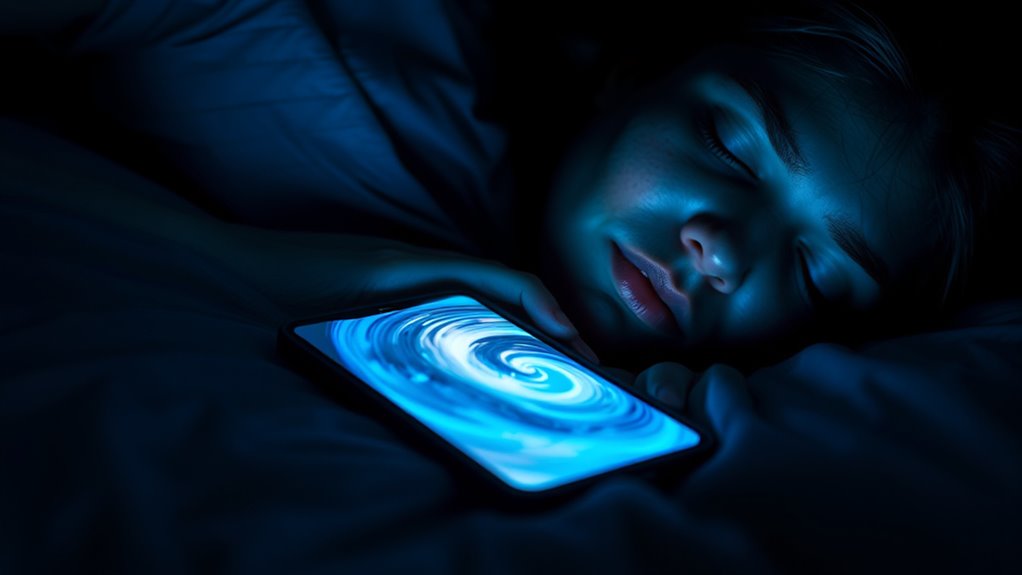In the digital age, your dreams are increasingly shaped by your digital habits and virtual experiences. Watching screens before bed, playing immersive games, or using neural interfaces can influence your subconscious, blending digital themes with real-life memories. Virtual sleep environments and stimuli during rest can even modify your dream narratives, making them more vivid or surreal. If you want to discover how technology’s blurring the line between dreams and reality impacts you, keep exploring.
Key Takeaways
- Digital habits, like social media and gaming, heavily influence subconscious dream content, creating vivid and surreal visions.
- Neural interfaces and virtual environments enable intentional manipulation of dreams, blending virtual themes with sleep experiences.
- Digital stimuli during sleep can shape dream narratives, leading to immersive, hybrid virtual-real dream scenarios.
- Overexposure to digital content may fragment dreams or make them hyper-real, blurring the line between reality and virtuality.
- The integration of digital influences into dreams impacts perception, cognition, and emotional processing in the digital age.

As technology advances, the boundary between dreams and reality becomes increasingly blurred. You might find yourself pondering whether your dreams are influenced by the digital world you engage with daily. Virtual sleep, a concept gaining traction, involves using immersive virtual environments or neural interfaces to alter or enhance your sleep experiences. Through these innovations, your brain could be exposed to specific stimuli during sleep, potentially shaping your dreams in ways never before possible. Digital dreams, or dreams influenced by digital content, are becoming a fascinating area of study and exploration. As you scroll through social media, watch digital films, or play virtual reality games before bed, you may unknowingly feed your subconscious new narratives. These experiences can seep into your dreams, creating vivid, sometimes surreal, digital-inspired visions that blend your waking world with virtual themes. This phenomenon raises questions about how much control you truly have over your dream content and whether your digital habits are subtly rewiring your subconscious mind.
The idea of virtual sleep doesn’t just involve passive consumption but active manipulation. Researchers are experimenting with neural interfaces that deliver specific patterns of stimulation to influence sleep stages or induce particular dream scenarios. Imagine falling asleep with the intention of dreaming about a favorite virtual adventure or a peaceful digital landscape—these processes could become routine with further advancements. The more you immerse yourself in digital environments, the more your brain adapts, integrating virtual elements into your dreams. This integration might enhance creativity, problem-solving, or even emotional processing, but it also raises concerns about overexposure to digital stimuli. If your brain increasingly incorporates virtual sleep experiences, your dreams could become more fragmented or hyper-realistic, blurring the lines between your physical experiences and digital impressions. Additionally, understanding the neural mechanisms behind dream content formation can help researchers develop better ways to influence or control dreams for therapeutic purposes.
Your digital habits—what you watch, play, or interact with online—can serve as the raw material for your dreams, creating a feedback loop that makes your subconscious more receptive to digital themes. The content you consume during the day influences your dream landscape, often making your dreams more vivid or bizarre when digital content is involved. As you lie in bed, your mind may craft stories inspired by virtual sleep scenarios, where digital dreams become a reflection of your online life. This ongoing interplay between technology and your subconscious might eventually shape your perception of reality itself, making it harder to distinguish what’s real from what’s digitally constructed. So, as you venture further into this digital age, remember that your dreams are no longer just spontaneous events—they’re increasingly shaped by the digital world you inhabit.
Frequently Asked Questions
Can Technology Help Enhance or Control Dreams Intentionally?
Yes, technology can help you enhance or control dreams intentionally through lucid dreaming and dream manipulation. Devices like sleep trackers and neurofeedback tools assist you in recognizing when you’re dreaming, making it easier to achieve lucidity. Once aware, you can consciously influence your dreams, exploring new scenarios or controlling outcomes. With practice and the right tech, you gain more mastery over your dream world, turning it into a playground for your imagination.
Do Digital Devices Interfere With the Natural Dreaming Process?
Digital devices can subtly disrupt your sleep hygiene, making it harder for you to enjoy restful sleep and recall dreams vividly. The blue light emitted from screens may interfere with melatonin production, dulling your dreaming experience. To keep your dreams lively and your sleep restorative, it’s best to limit device use before bed. This small change helps preserve your natural dreaming process and boosts dream recall, enriching your nightly journeys.
How Do Social Media Influences Appear in People’s Dreams?
You might notice social media influences in your dreams through vivid dream symbolism, like seeing yourself scrolling or receiving messages. These symbols reflect your subconscious engagement with social media, revealing your feelings or anxieties about online interactions. As you dream, your mind processes digital experiences, turning them into symbolic images or scenarios that mirror your real-life social media habits and emotions, blending technology with your subconscious thoughts.
Are There Specific Apps Designed to Record or Analyze Dreams?
Yes, there are apps designed for dream recording and sleep analysis. You can use these apps to log your dreams immediately after waking, helping you track patterns and themes over time. They often incorporate features like voice memos or journaling options for dream recording, plus sleep cycle monitoring. By analyzing your sleep data, these apps can give you insights into how your dreams relate to your daily life and digital habits.
Can Virtual Reality Experiences Alter Future Dream Content?
Did you know that 65% of people report vivid dreams after immersive virtual reality experiences? Virtual reality can indeed influence your future dream content by enabling dream manipulation, where your brain processes these intense experiences during sleep. When you engage with VR, it can create new neural pathways, potentially altering themes and images in your dreams, making them more vivid, adventurous, or surreal.
Conclusion
While some might think technology only distracts us, it actually shapes our dreams in surprising ways. Imagine scrolling through social media before bed—your mind weaves those images into your nighttime stories. By understanding this link, you can use tech intentionally to influence your dreams positively. Embrace your digital habits, knowing they’re part of your subconscious landscape. After all, your dreams are your mind’s canvas—tech is just adding new colors.










